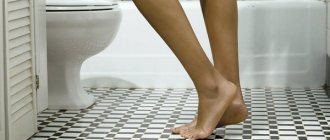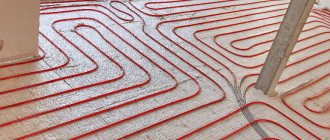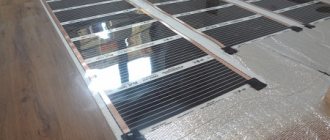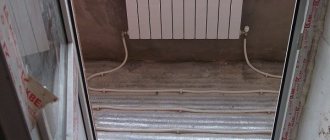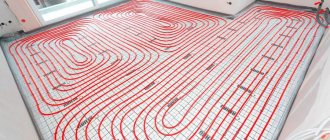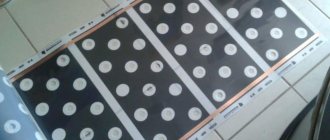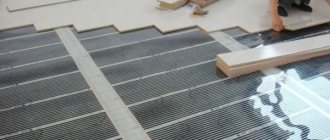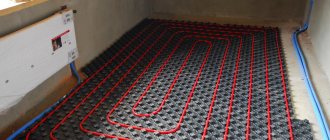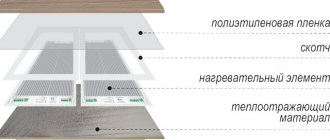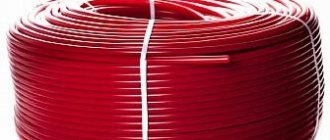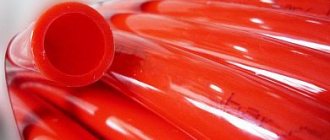Today, having a heated floor in a house or apartment is far from a luxury and not uncommon. Any owner of a private house or apartment can easily buy and install it, either independently or with the help of specialists (depending on the type and method of fastening the heated floor pipes). Most often, people install such floors not for their own comfort, but for their children. In addition, the heat from the floor is evenly distributed over the entire area of the room in which it is installed. Nowadays, in markets and specialized stores, customers are presented with a wide range of different heated floors. Their differences are only in price and installation method.
Fastening the pipe to the reinforcing mesh
The pipe is loosely attached to the mesh (a distance of several centimeters) and is fixed using special clamps. The staples are attached one at a time at a distance of one and a half meters from each other, but when the pipe is bent by 90 degrees, the pipe is secured with three staples for a more reliable fixation.
On our second channel, Andrey Elfimov talked about a useful life hack for attaching a heated floor pipe to a reinforcement mesh:
Advantages: All elements of this method of pipe fastening are available in specialized stores or on the market. A simple and reliable way.
Disadvantages: Labor-intensive installation process.
The possibility of damage to the pipe cannot be ruled out, since metal-plastic pipes are often used.
Which underfloor heating fasteners should I choose?
The choice depends entirely on personal preference. Here you need to weigh the pros and cons, and then decide on the most optimal option. If it’s difficult to do this on your own, you can always turn to specialists in your field:
- using polystyrene plates, you can install the system as quickly as possible;
- metal mesh is chosen by those who want to save money;
- anchor brackets are an option for those who are not afraid of difficulties and want to get only the best option.
When deciding on the type of fastener, you need to take into account your personal financial capabilities, the operating characteristics of the system, as well as the time available for installation.
It is worth considering any risks in the operation of the system that could lead to the destruction of the work done.
Using brackets for heated floors, you won’t have to worry about the pipes coming out of place under high pressure or mechanical stress, which will require repairs to the entire system.
- Related Posts
- How to turn on the heated floor?
- Which is better, warm floors or radiators?
- How does radiant floor heating work?
- How to install a heated floor sensor?
- How to set up a programmable thermostat for heated floors?
- How to install Grand Meyer underfloor heating?
Fastening the pipe to mounting rails
This method is no more complicated than the previous one. The pipes are fixed using special clamps that tightly hold and protect the system from mechanical damage. Also, such systems are easy to install on the wall; the only problem is that it is quite difficult to find such a heating system in specialized stores. In addition, difficulty arises in the preliminary marking. But in general, this method is very convenient and practical.
Choosing the optimal step
After selecting the material and method of pipe placement, you need to determine the distance between adjacent turns of the circuit. It does not depend on the type of placement of coolants, but is directly proportional to the diameter of the pipes. For large sections, too small a pitch is unacceptable, just as for pipes with a small diameter, a large pitch is unacceptable. The consequences may be overheating or thermal voids, which will no longer characterize the heated floor as a single heating system.
Video - Warm floor "Valtek". Installation instructions
A correctly selected step affects the thermal load of the circuit, uniform heating of the entire floor surface and the correct operation of the entire system.
- Depending on the diameter of the pipe, the pitch can range from 50 mm to 450 mm. But the preferred values are 150, 200, 250 and 300 mm.
- The spacing of coolants depends on the type and purpose of the room, as well as on the numerical indicator of the calculated heat load. The optimal pitch for a heating load of 48-50 W/m² is 300 mm.
- For a system load of 80 W/m² or more, the pitch value is 150 mm. This indicator is optimal for bathrooms and toilets, where the floor temperature must be constant according to strict requirements.
- When installing heated floors in rooms with a large area and high ceilings, the coolant laying step is taken to be 200 or 250 mm.
Warm water floor installation project
In addition to a constant step, builders often resort to the technique of variable placement of pipes on the floor covering. It consists of more frequent placement of coolants in a certain area. Most often, this technique is used along the line of external walls, windows and entrance doors - maximum heat loss is noted in these areas. The value of the increased pitch is determined as 60-65% of the normal value, the optimal value is 150 or 200 mm with an outer pipe diameter of 20-22 mm. The number of rows is determined during the laying process, and the calculated safety factor is 1.5.
Schemes for enhanced heating of external walls
Variable and combined laying steps are practiced in external and peripheral rooms due to the urgent need for additional heating and large heat losses; in all internal rooms the usual method of placing coolants is used.
The process of laying underfloor heating pipes is carried out in strict accordance with the project
Expanded polystyrene boards with fixation
Option 1
A very creative way to install pipes. Since with the help of volumetric protrusions on the coating, pipes can be laid in any pattern as you wish. Despite the small distance between the protrusions, many people think that this is what will fix the pipe, but this is far from the case. For fixation, special clips are also used, which guarantee the reliability of a strong fastening of the pipe.
Advantages: The pipe is protected by special bosses from mechanical damage. Such a system can be freely purchased both on the market and in a specialized store.
Disadvantages: Quite a high price for all components. To fix the pipe, additional elements must be used.
Option 2
This installation method is very similar to the previous one, but there are significant differences. There are special protrusions on the coating that firmly fix the pipe without any additional equipment. You can fix the pipe in a very simple way: by carefully pressing the pipe between these protrusions.
Advantages: This method of attaching a pipe is considered very convenient and reliable. The slab is not damaged when moving across the floor. An excellent combination of functionality, quality and price.
Disadvantages: The cost is much higher than the earlier examples. Such a specimen is quite difficult to find in markets and specialized stores.
Perforated plates
The liquid line is laid on perforated plates. They are made of polystyrene foam and have a contoured surface with fixing elements or without special devices. What are the characteristics of the slabs?
- The thickness of the mat is 1-3 cm.
- Outline height 2.5 cm.
- The distance between the contours is 2-5 cm.
- The material can withstand high temperatures and changes in thermal conditions.
- Expanded polystyrene does not deform under the influence of a deep concrete screed.
- The mats will serve as additional thermal insulation and noise protection.
The pipeline is removed using a snail or snake. If the contour is located at a distance of 16-20 mm, then it reliably holds the line. The bosses fit around the pipes on the sides. There is no need for additional fastenings. If the distance between the circuits is greater than the outer diameter of the pipe, then it is necessary to take care of the mounting elements. Holes are provided in the bosses for staples.
The perforated surface may not have bosses that rise on the surface of the mat, but grooves. Their width corresponds to the diameter of the water circuit pipe. In order for the loop to turn without loads and to correspond to the bending radius, the mats are provided with perforations in the form of a loop.
If a reflective screen is not provided for the heated floor, then mats with a foil surface are chosen. The material has only one drawback, which is associated with the high cost of the product.
We recommend: How to choose a wire for a heated floor?
Fastening with a tucker
The pipe is secured using a special device - a tucker, which holds about 120 clamps. Using this device, the pipe is fixed according to the markings. The process takes a small amount of time, but despite the speed of fixing the pipe, the fastening is very reliable. The only disadvantage of this method is the cost of the equipment - 230 euros. It is very difficult to find it in a domestic specialty store. This method of fastening is suitable for installers and qualified specialists in this field.
Velcro
suggests using the Rautherm Speed system as a fastener for the floor water line. It consists of a covering on which there are small loops and a tape with hooks on it. The system works on the Velcro principle. Purchase the fastening system from dealers in Moscow and St. Petersburg.
A tape is wound around the pipe and placed on mats with loops. The hooks fit into the loops and fix the contour in a certain place. If necessary, the location of the highway can be adjusted.
The mats have a thickness of 3 mm. They are an additional thermal insulation material for the floor and prevent noise from entering the room.
On the outside they have a sticky surface, which is protected with tape. When laying the mats, the tape is disconnected and the roll is rolled out over the floor surface. The material is designed for pipes with a diameter of 14-20 mm. Withstands pressure 6 bar, temperature 95 0C. The installed system is filled with concrete screed.
A variety of devices are used to secure the floor water main pipeline. Methods are selected based on installation efficiency and product cost. Small costs will be required to lay the highway using reinforced mesh and mounting tape.
YouTube responded with an error: The request cannot be completed because you have exceeded your quota.
- Related Posts
- Features of Fenix heated floors
- How is a heated floor connected?
- How to connect a heated floor from a stove?
- How does a water heater for underfloor heating work?
- How to lay a heated floor under PVC?
- Is it possible to lay laminate flooring on a heated floor?
What method do we use?
For a long time we used the method of attaching pipes to reinforcing mesh. There were many reasons for this: price, lack of other offers and expensive delivery to order. Now we are bringing anchor brackets and securing the pipes with a tacker. This significantly speeds up the installation process. Difficulties usually arise when pipe lines run at close distances. The tucker does not fit into the gap between the pipes and our tucker often makes false alarms. It is still unknown whether this is a feature of all tucker machines or just ours.
